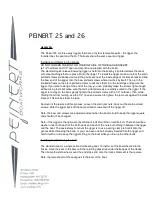
J/35
Tuning Guide
18
TIPS & TECHNIQUES
When running in less than 20 knots,
keep the crew weight forward, low
and wide to lower the CG and damp-
en the rolling moments.”
Jack Slattery, North Sails Northeast
“To get the best downwind VMG, ask
one of your crew to face aft and
position the boat in the lanes of
strongest wind and clear air.”
Dan Neri, North Sails Rhode Island
“When tacking downwind, memorize
how far the pole is from the headstay
so it can be duplicated on the oppo-
site gybe.”
Benz Faget, North Sails New Orleans
“If you put more than three people in
the cockpit, the boat does a wheelie,
and there is no room to move.”
Chris Shining, NS San Francisco
“Best running VMG is achieved by
setting the twings low and carrying
2°-5° of weather heel allowing the
rudder to develop slight lee helm.”
Perry Lewis, North Sails Midwest
“If another boats windex tail is
pointing at you, reposition your boat
to clear.”
Hugh Beaton, North Sails Toronto
“Taping the spinnaker sheet to the
guy will allow you to put both into
the pole preventing a lock-out.”
Ken Read, North Sails Rhode Island
“Spinnaker halyards can be uncov-
ered, small diameter 9mm Spectra,
but using high-modulus
Vectran/Technora (9mm) for the main
and genoa halyards works the best.”
Jody Lutz, North Sails East
“When running, positioning the crew
weight forward to keep the knuckle
immersed to maximize running
length. That‘s fast!”
Ron LaNeve, North Sails New Jersey
“If you need to add weight in order
to meet the float lines, fill one tank
at a time right to the top.”
Dave Miller, North Sails Vancouver
“On a windward-leeward course, you
do not need to release the vang to
go downwind.”
Henry Little, North Sails Rhode Island
“When sailing upwind (under 11
knots true ) with full crew weight on
the rail, keep the lower mainsail
leech touching the checkstay to
induce weather helm.”
Will Keyworth, NS Chesapeake
“In winds over 14knots true, you lose
three boat-lengths per tack. Compare
the number of tacks you do to the
boat which won the beat.”
Jack Christiansen, North Sails Seattle
“ Keep the main and genoa halyards
in the self-tailing winches so they
don‘t slip and can be adjusted during
a tack.”
Jon Gardner, North Sails San Diego
“Storing all loose gear aft of the
bulkhead on the floor improves the
CG.”
Henry Bossett, NS New Jersey
“Did you know, every antennae, hal-
yard and external block carries a
weight and windage penalty?”
John Gladstone, NS San Diego
“Keep a log of your headstay
length/windspeed relationship to be
able to repeat fast settings.”
Jeff Madrigali, NS San Francisco
“Pulling the rig forward downwind
stabilizes the spinnaker, reduces the
rudder motion to maintain a steady
course and tightens the vang.”
Jim (Fuzz) Foster, North Sails Hawaii
“When you tail the genoa sheet hard
enough and tack slowly enough it is
possible to keep the genoa clew
inside the lifelines.”
Bear Hovey, North Sails East
“When sailing upwind in under 6
knots, ask your crew to stay below
to condense the CG and control
pitching.”
Chris Shining, NS San Francisco
“Tie the D1 and V1 together tightly
to minimize windage.”
Bill Herrschaft, NS Marina del Rey
“For windward spinnaker takedowns,
use a bow bag in the forward hatch
which eliminates the need to re-pack
the chute. You are ready to go for the
next hoist.”
Jeff Holstrum, North Sails Seattle
Thanks to everyone who contributed
to this tuning guide. There’s lots of
talent racing in the J/35 class, if you
need help with speed, give any one
of these guys a call, they are happy
to help.



































